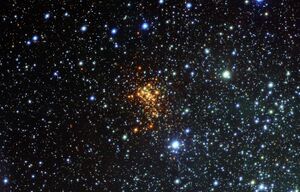Astronomy:Westerlund 1-20
Coordinates: ![]() 16h 47m 04.70s, −45° 51′ 23.96″
16h 47m 04.70s, −45° 51′ 23.96″
| Observation data Equinox J2000.0]] (ICRS) | |
|---|---|
| Constellation | Ara |
| Right ascension | 16h 47m 04.69s[1] |
| Declination | −45° 51′ 23.9″[1] |
| Characteristics | |
| Evolutionary stage | Red supergiant |
| Spectral type | M3[2] - M6I[3] |
| Apparent magnitude (J) | 6.378 |
| Apparent magnitude (H) | 4.381 |
| Apparent magnitude (K) | 2.61 |
| Astrometry | |
| Proper motion (μ) | RA: −2.478[4] mas/yr Dec.: −4.041[4] mas/yr |
| Parallax (π) | 0.1690 ± 0.1073[4] mas |
| Distance | 2,600+600 −400 (assumed)[5] pc |
| Details | |
| Radius | 858±48[2] R☉ |
| Luminosity | 101,000±13,000[2] L☉ |
| Temperature | 3,284 - 3,550[2] K |
| Other designations | |
Westerlund 1 W20, Westerlund 1 BKS D, 2MASS J16470468-4551238, Gaia EDR3 5940106007092341120 | |
| Database references | |
| SIMBAD | data |
Westerlund 1-20 (abbreviated to Wd 1-20 or just W20) is a red supergiant (RSG) located in the Westerlund 1 super star cluster. Its radius was calculated to be around 965 solar radii[1] (6.72 × 108 km, 4.48 au), making it one of the largest stars discovered so far. This corresponds to a volume 899 million times bigger than the Sun. If placed at the center of the Solar System, the photosphere of Westerlund 1-20 would almost reach the orbit of Jupiter.
The star is classified as a luminous cool supergiant emitting most of its energy in the infrared spectrum.[6] W20 occupies the upper right corner of the Hertzsprung-Russell diagram. Using the effective temperature of 3,500 K,[1] the bolometric luminosity of 126,000 L☉[1] and the solar effective temperature of 5,772 K,[7] its radius can be calculated using the Stefan-Boltzmann law.[lower-alpha 1]
Westerlund 1-20 was observed to have an extended, cometary shaped nebula, similar to the other red supergiant Westerlund 1 W26. It is therefore likely that its morphology was affected by either the intracluster medium or the cluster wind of Westerlund 1.[8] The nebulae of both Westerlund 1-20 and Westerlund 1 W26 are extended outward from the cluster core and most bright at inward direction, indicating the outward cluster wind.[9]
See also
Notes
- ↑ [math]\displaystyle{ \sqrt{\left(\frac{5772}{3500}\right)^4\cdot 125893}\approx964.98 \ R_\odot }[/math]
References
- ↑ 1.0 1.1 1.2 1.3 1.4 Fok, Thomas K. T.; Nakashima, Jun-Ichi; Yung, Bosco H. K.; Hsia, Chih-Hao; Deguchi, Shuji (2012). "Maser Observations of Westerlund 1 and Comprehensive Considerations on Maser Properties of Red Supergiants Associated with Massive Clusters". The Astrophysical Journal 760 (1): 65. doi:10.1088/0004-637X/760/1/65. Bibcode: 2012ApJ...760...65F.
- ↑ 2.0 2.1 2.2 2.3 Arévalo, Aura (2019). The Red Supergiants in the Supermassive Stellar Cluster Westerlund 1 (Thesis). doi:10.11606/D.14.2019.tde-12092018-161841.
- ↑ Westerlund, B. E. (1987). "Photometry and spectroscopy of stars in the region of a highly reddened cluster in Ara". Astronomy and Astrophysics Supplement Series 70: 311. Bibcode: 1987A&AS...70..311W.
- ↑ 4.0 4.1 4.2 Brown, A. G. A. (2021). "Gaia Early Data Release 3: Summary of the contents and survey properties". Astronomy & Astrophysics 649: A1. doi:10.1051/0004-6361/202039657. Bibcode: 2021A&A...649A...1G. Gaia EDR3 record for this source at VizieR.
- ↑ Aghakhanloo, Mojgan; Murphy, Jeremiah W.; Smith, Nathan; Parejko, John; Díaz-Rodríguez, Mariangelly; Drout, Maria R.; Groh, Jose H.; Guzman, Joseph et al. (2020-02-21). "Inferring the parallax of Westerlund 1 from Gaia DR2". Monthly Notices of the Royal Astronomical Society 492 (2): 2497–2509. doi:10.1093/mnras/stz3628. ISSN 0035-8711. Bibcode: 2020MNRAS.492.2497A.
- ↑ "Cl* Westerlund 1 W 20". http://simbad.u-strasbg.fr/simbad/sim-id?Ident=Cl*+Westerlund+1+W+20.
- ↑ Williams, D. R. (2013). "Sun Fact Sheet". https://nssdc.gsfc.nasa.gov/planetary/factsheet/sunfact.html.
- ↑ Dougherty, S. M.; Clark, J. S.; Negueruela, I.; Johnson, T.; Chapman, J. M. (2010-02-01). "Radio emission from the massive stars in the galactic super star cluster Westerlund 1" (in en). Astronomy & Astrophysics 511: A58. doi:10.1051/0004-6361/200913505. ISSN 0004-6361. Bibcode: 2010A&A...511A..58D.
- ↑ Andrews, H.; Fenech, D.; Prinja, R. K.; Clark, J. S.; Hindson, L. (2018), "Asymmetric ejecta of cool supergiants and hypergiants in the massive cluster Westerlund 1", Monthly Notices of the Royal Astronomical Society: Letters 477: L55–L59, doi:10.1093/mnrasl/sly046, Bibcode: 2018MNRAS.477L..55A
 |



